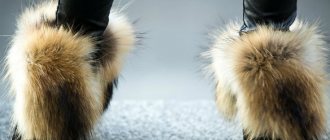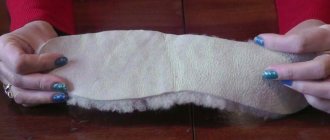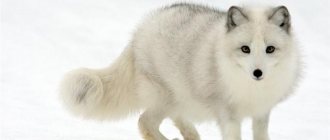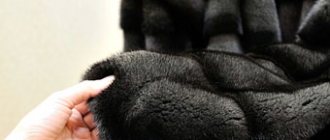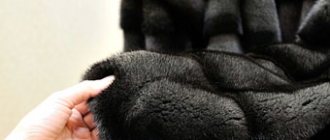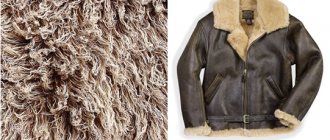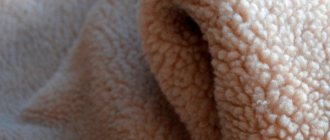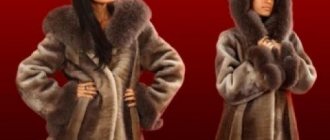Dressing sheep skins can be a good source of income for private businesses. But this is not an easy way to make money and is not very healthy.
Since modern methods of processing hides are based on the use of chemicals. And inhaling their vapors is not what the human body needs. But if you raise sheep, then throwing away their skins is simply wasteful. Therefore, it makes sense to learn how to dress hides, at least for yourself. Let's look at the theory, and practice is up to you.
What is a mouton?
Mouton is a refined sheepskin, dressed in a special way and treated with formaldehyde, which “preserves” the hairs of the wool. Mouton comes from the French word mouton and means sheepskin, ram, valuh.
Mouton is 100% natural fur of natural origin, which provides the best protection from cold, wind, moisture and other weather conditions,
allows you to maintain body temperature and protect from physical environmental influences.
The mouton gained popularity due to the positive properties of fur. Mouton is a soft, durable and very practical material. It has excellent shine, lightness, elasticity and does not pill when worn daily. For a long time it retains its excellent appearance, the pile does not break or deform.
The fibers of sheepskin fur create a natural layer of air and maintain air circulation, which has a beneficial effect on the microclimate of the body, retains heat, preventing freezing at the lowest temperatures, in harsh climates.
Content:
What is mouton made from? Mouton production technology Mouton coats - a budget option Miraculous sheepskin fur Sheepskin in modern fashion Sheepskin production History of sheepskin Sheepskin on fashion catwalks
Fur or wool: what to choose
We have put together expert advice to help you decide on the right option:
- If your feet are constantly cold, spend a lot of time outside in the cold, buy shoes with fur insulation. Natural fur is warmer than wool, provided it has a dense pile. “Rare” fur will not warm your feet even at a slight minus.
- The best option for extreme cold is a two-layer leather (outer material and fleece inside) plus a fur lining. For residents of northern regions, where winter temperatures hover around minus 25-30 degrees, we recommend buying woolen felt boots, fur high boots, and boots with woolen fur.
- If it's not too cold outside, shoes with fur are not needed. Your feet will overheat and sweat. This does not have the best effect on health and well-being.
- Natural wool is more practical than fur. If you have to walk a lot, we recommend choosing this insulation. As you wear it, it becomes denser and warms well. Recommended at temperatures from 0 to minus 15 degrees.
- Shoes with a wool lining look lighter, sleeker, and more elegant. If this parameter is important, then wool is your choice. For older people, for whom practicality and convenience are a priority, we recommend fur.
Ideally, you should have two or three pairs of winter shoes. Dry and air your boots after wearing them. A fur lining dries in 18-20 hours, and a wool lining in 8-10. Don't forget to take care of your shoes. Then the new pair will last for several seasons.
What is mouton made from?
The Australian Merino is a breed of fine-wool sheep bred in Australia.
Merino wool is fine-wool wool, less than 24 microns thick, sheared from the withers of sheep raised in special nurseries in Australia and New Zealand. The beneficial properties of merino wool have been known to mankind for a long time. The ancient Scots wore clothes made from this wool by heating it over steam. Now it looks a little strange, because putting on wet clothes is uncomfortable even in summer. The fact is that slightly wet merino wool becomes hygroscopic. It is capable of absorbing up to 33% of moisture from its volume, heating up to the temperature of the human body and remaining not blown through. In Spain, products made from merino wool were intended only for the royal court; export outside the state was punishable by death. Widespread industrial use only began at the end of the 18th century, when the British managed to smuggle merino sheep to Australia.
Merino wool is an excellent thermoregulator, trapping a large mass of air inside the high layer of fibers. Maintains a constant body temperature without overheating. At the same time, it absorbs moisture from excessive sweating and provides ideal ventilation. It is also worth noting the medicinal properties. Products made from merino wool provide micro-massage that improves blood circulation. Recommended for rheumatic diseases, arthritis, back and spine pain. In addition, merino wool is very elastic - even if the product is stretched by 30%, it takes its original shape. Thanks to this property, products made from merino wool are considered very durable.
Australia and New Zealand are famous for their grazing and sheep farming. Therefore, raw materials are purchased there, which are produced in Russia using special technology. Australian mouton is the fur of sheep of the Australian breed. Manufacturers have long noticed that the skins and fur of this breed compare favorably with others. The skin (dermis) is much thinner than that of sheep raised in Russia. In addition, Australian fur is thinner and more pleasant to the touch. This is due to the fact that Australia has a much milder climate than ours.
Russian fur is also suitable for clothing production. It is used to make sheepskin coats, hats, shoes, sofa covers and carpets. However, fur coats and hats made from sheepskin are not of such good quality, due to the denser dermis. Therefore, many manufacturers around the world have long switched to Australian fur.
Mouton production technology
The production of mouton is a Russian technology, therefore mouton products are sewn only in Russia. Russian specialists, using imported equipment, produce, dye, and sew mouton fur coats. Mouton is not produced abroad due to the smell of formaldehyde, which is released during the processing of skins; this is considered a hazardous production.
In factories, for the production of mouton, the wool of dressed sheep skins is carefully sheared, leaving the required length of pile, then during tanning, raw sheep skins are treated with a formaldehyde preservative solution, carefully processing each wool so that the fur acquires extraordinary softness and shine. Thanks to this treatment, the fur material becomes resistant to moisture and mechanical damage.
They also perform deep dyeing or tinting, since the natural color of the material is not very beautiful. The fur acquires a “noble”, rich color and attractive appearance. The color of the dyed mouton can vary from snow white to jet black. There are about two dozen shades; the most common muton colors are black and brown.
Romanov sheepskin (1st group)
The sheepskin coat from group 1 is devoid of any signs of shedding and matting. At a quick glance, it appears in various shades of steel gray. Upon closer inspection, you can see shades of light blue when divided into several rows of main braids. Most of the skin of the braid has small curls. It is acceptable to have a small amount of felted wool, which is easy to comb, and a dark stripe in the area of the back, withers or neck, which is slightly different in color from the main fibers.
Mouton fur coats - a budget option
Thanks to the rich color range of finished products, even the most fastidious customers will be able to make a choice.
The excellent compatibility of the mouton with other furs allows you to create dozens of different fur products, different styles and models, both for young people and for women of any age. Mouton - has high strength and excellent wear resistance, resistant to precipitation - wet snow, wind. Products made from mouton are easy to care for and can be easily cleaned with a regular damp handkerchief. The Russian mouton is designed for a service life of 5 – 7 years. If you follow the storage rules, products made from Australian Mouton fur will last up to 10 years.
Mouton products are the ideal balance of beauty, style, warmth and convenience. Mouton fur coats are elegant, comfortable, practical, and durable. This fur retains heat perfectly, perfectly resists moisture and is very wearable. It is light, elastic and does not pill even with daily wear. Mouton is also an excellent alternative to expensive furs. The main advantage of this fur is its affordability. Any woman who dreams of practical, warm and very beautiful winter clothes can afford to buy a product made from mouton.
A mouton fur coat is a budget, economical option available to every fashionista. Prices for fur coats made from mouton are much lower and more affordable compared to similar products made from mink, beaver, and chinchilla fur. Mouton products are leaders in the winter outerwear market in the CIS countries.
Tanning hides at home, step-by-step instructions for processing at home
Many sheep farmers are faced with the problem of finding collection points for raw hides.
If the herd is large, then it makes sense to sell a lot of raw materials in bulk at once, but what about those who have less than a dozen sheep? Dressing sheep skins is a multi-step process that requires diligence and even physical strength.
This business is usually carried out by specialists, but, if desired, every beginner is able to master the furrier's craft. Let's learn how to make and preserve sheepskin yourself. Preparation procedure:
- Make the first cut at the neck, lead it through the stomach - to the root of the tail. Then make circular cuts near the carpal and hock joints, located on the front and hind legs respectively. Remove the skin with a knife, trying to avoid any damage - a tear or cut.
- After removing large debris from the sheepskin, lay it with the flesh side up.
- Carefully inspect the leather surface, if there are remains of meat, fat, tendons on its inside, scrape them off with a knife.
- Fold the sheepskin in half and leave it for a couple of hours to cool in a cool room.
- After two hours they begin dressing. You can't wait more than two hours.
Miraculous sheepskin fur
Sheepskin fur has excellent heat-protective properties, practicality and versatility, and does not get wet when exposed to moisture. Products made from natural sheepskin are very warm, provide air circulation, this eliminates the “greenhouse effect”, that is, they allow the body to breathe. The wear resistance of sheepskin products is 55% of the accepted standard, so a fur coat or hat will be worn for at least 6 seasons.
Previously, underweight children were placed on sheepskin bedding. On sheep skins, children quickly calmed down and cried less. Plus the complete absence of allergies. Similar experiments were carried out at home with normal children - with the same excellent results.
Sheepskin fur promotes faster development of the baby in external conditions, it does not lose heat and always remains dry. Provides effective prevention of colds and infectious diseases. Sheep skin warms the child, calms him down, improves blood circulation, and as a result relieves abdominal pain in a child suffering from gas. Normalizes intracranial pressure - the cause of headaches, anxiety, poor sleep and appetite, improves blood circulation and microcirculation, and also improves muscle tone. In the future, children who were exposed to lamb skins in the first months of life are much less likely to suffer from viral and bacterial diseases.
Tanning and Processing of Sheep Skins: A Complete Guide
Preservation of hides
If the skins are not going to be processed immediately after removal, they must be preserved. This can be done in two ways:
- wet salted;
- dry salt method.
Wet salted method
The sheepskin is laid out in a dry, cool, shaded place without direct sunlight. For preservation you need:
- place the skin with the flesh side up;
- straighten so that there are no folds;
- spread a thick layer of salt evenly over it;
- leave for three days,
- if everything is absorbed, then pour salt again, fold and roll the skin;
- after three days, unwrap the skin and let the phlegm drain;
- then fold and roll again.
By repeating these operations, in eight to ten days the skin will be salted. The purpose of this operation is to prevent the spread of germs and fur loss. Before rolling the skin, it must be folded with the flesh inward in this way:
- the upper part is bent by a quarter;
- side parts - to the middle and also a quarter;
- the skin is folded along the ridge;
- they begin to roll from the neck;
- the resulting bundle is tied with a rope.
Skins preserved by wet-salting are considered the best preparations.
Dry salted method
The initial operations are the same as with the wet-salted method. Naphthalene can be added to salt to repel various pests.
After sprinkling the skins with salt, they are stacked. After a couple of days they begin to dry unrolled. They are hung on poles along the ridge line.
Dry on both sides. First, the inside side up, and then the fur side out. The initial temperature should not exceed twenty degrees. Before drying is completed, the heating temperature is adjusted to thirty degrees. Skins should not be dried in direct sunlight.
Instructions for preserving hides
When scattering salt for preservation, distribute it evenly over the entire area of the skin. Dry and store them in a shaded place. Otherwise it will become a stake and crack.
When storing, they need to be constantly checked, ventilated, and the fur tugged. If he starts to climb, the skin will soon deteriorate. In this case, the salting procedure must be repeated.
It is not advisable to store canned skins for more than six months.
Stages of dressing
The skins of any animal go through the same stages during dressing.
When dressing the skin, the following stages go through:
- soaking or soaking;
- fleshing;
- degreasing;
- pickling;
- tanning;
- fat;
- drying.
Flesh
After soaking, the skin is laid out on a flat surface and scraped along the inside. To do this, use the blunt side of a knife, a scraper, or a staple.
Remove remaining fat, films and fiber.
Degreasing
To degrease thin skins, a soap solution or a solution of washing powder at the rate of three and a half grams per liter of water at room temperature is sufficient.
For the skin of a fattened animal, you will have to prepare a special solution. After waiting for half an hour, rinse them well in cool water. They squeeze it out. They hit the fur with a stick. The flesh is dried with rags and rags.
Pickling
Pickling means “pickle” in English. Indeed, for this procedure, a solution is prepared similar to a marinade for homemade pickles.
If the skin is not intended to be used for clothing or direct contact with humans in the future, then you can leave it as is. If they want to sew something from sheepskin, then the pickel solution is neutralized.
Recipe for neutralizing solution. This operation reduces the strength of the tanned skin, but it will not cause allergies. The pickling process is considered complete when it is well washed in running water.
Tanning
At home, plants containing tannin are used for tanning. These include willow and oak bark. Oak bark gives light skins a red tint. If you want to keep the hide white, use willow bark.
The tanning solution is prepared in two stages.
Preparation of tanning solution.
Impregnation with tanning solution continues for two days. The end of the tanning process can be determined by the cut. Examine a small section of skin through a magnifying glass. Uniformity of color indicates the end of the process.
To enhance the tanning effect, you can add horse sorrel root in the form of a decoction to the solution. Chromium alum can be used for tanning. The readiness of the skin is checked, as in the previous case.
The skin is dried for two days. Then neutralization is carried out as described above. If not the entire skin was dipped into the solution, but only the inner skin was coated, then neutralization does not need to be carried out.
After this, the skin is washed well in running water. To improve the quality of the fur, it can be washed with shampoo. Only wash one fur, without touching the inside. Otherwise she will be tough.
Zhirovka
After this operation, the skin becomes elastic. It involves coating the insides with a fat emulsion. Before carrying out this procedure, the skin must be stretched.
Emulsion recipe
The grated soap is poured with water. Cook over low heat until the soap dissolves. Pork fat is added in small portions. After cooling the mixture a little, add ammonia.
Coat the flesh with the emulsion. Be careful not to get it on the fur. After coating, fold the skins skin side to side. If you accidentally stain the fur, you can clean it with gasoline.
Drying
To dry the skin you need a temperature of 30 degrees. During the drying process, it must be kneaded and stretched frequently. This makes it softer. When the skin begins to dry out and dry marks begin to appear, then the skin should be stretched a little and the inside should be cleaned with pumice. The drying process usually lasts for three days.
Source: https://fermers.ru/zhivotnovodstvo/ovcy/vydelka-shkur
Sheepskin in modern fashion
The well-known phrase “Sheepskin is not worth the candle” is not about sheepskin fur, which is extremely popular, despite its centuries-old age and competition among its more fluffy relatives. Sheepskin coats or “Siberian sheepskin coats,” as they are called in the West, are fashionable, comfortable and practical everyday clothing.
Fashionable sheepskin coats and sheepskin coats are also relevant, only the style has changed a little. They are beautiful, warm and comfortable, with a high, voluminous collar or a fold-over double collar. The length can be either short or extended to the knees.
It is preferable to choose sheepskin products in brown colors - chocolate, cream, sand. But the color scheme may not be limited to one shade and amaze the imagination with the play of a wide variety of tones, from snow-white to blue.
Short sheepskin jackets with a large fox or arctic fox collar look very stylish. Also distinctive are short military-style aviator jackets, decorated with leather straps and metal details.
Sheepskin coats look great in an ensemble with mini shorts, a pencil skirt, leather trousers and a knitted dress. However, stylists warn: do not overdo it with volume. If the upper part of your silhouette is voluminous, then it is advisable to visually narrow the lower part.
Sheepskin production
Sheepskin is a skin taken from an adult sheep and young animals over 6 months old. The structure of sheepskin wool is characterized by a thin epidermis. The dermis consists of thin fibers intertwined in a horizontal direction. The boundary between the papillary and reticular layers of the dermis is quite clear. The thickness of the papillary layer is usually greater than the thickness of the reticular layer. Sheepskin leather and fur have low strength, especially the outer layer of the skin, strong ductility, high looseness and water permeability. Mereya leather made from sheepskin has evenly distributed small pores and a fairly smooth surface.
Based on the hair structure, sheep are classified into: fine-fleece, semi-fine-fleece, semi-coarse-wool and coarse-wool.
Sheepskin is a popular type of fur raw material. There are three groups of sheepskin: fur, fur and leather.
In fur production, fine-fleece, semi-fine-fleece, fine-fleece and coarse-wool sheep are used, with uniform or heterogeneous semi-coarse wool with a significant fluff content. Which have secondary hair, which consists of thin, thick hair (staple fleece). It contains up to 35% fat from the weight of the fleece, which gives the hair a yellowish tint. The hair coat of fine-fleece and semi-fine-fleece sheep consists mainly of downy hair. The fleece of semi-coarse-wool sheep contains transitional and guard hairs. According to the height of the hair, sheepskin is divided into wool (over 5 cm), half-wool (from 2 to 5 cm) and bare (up to 2 cm).
Depending on the breed and quality of hair, sheep are divided into types - Russian, steppe, Mongolian, Romanov. Sheepskin fur is used to make women's and children's coats, men's and women's collars, and hats, with the hair facing outward. Fur sheepskin is used for sheepskin coats. Sometimes covered with a film for a waterproof effect.
In the sheepskin and fur production, coarse-wooled sheep are used, with heterogeneous, mixed wool of at least 1.5 cm in length. From the fur sheepskin, after dressing and dyeing, headwear is made - short fur coats, sheepskin coats, jackets. In this case, the skin part of the sheepskin (mesh) faces outward, and the wool faces inward. The most suitable for sheepskin and fur production are the skins of sheep of the Romanov breed, especially at the age of 5-8 months. The ratio of the number of downy and guard hairs in the wool of the Romanov sheep prevents felting and ensures the preservation of the curl during wear, which gives it good heat-protective properties.
In leather production, sheep skins are used, the quality of the hair does not meet the requirements of fur and sheepskin production. Sheep skins used for leather production are divided into 4 groups:
— Russian, includes the skins of all coarse-wool sheep breeds, with the exception of fat-tailed ones. Suitable for the production of chrome-tanned leather for shoe uppers - chevrette.
— Steppe, includes the skins of fat-tailed and adult Karakul sheep. The skins are very oily, so the skins are loose, viscous and have a weak, fragrant (easily crushed, separated) outer layer. They are used to produce haberdashery, lining and mitten leather.
- Crossbred.
— Fine-wool sheepskin.
Depending on the origin of the sheep and the method of dressing, there are many names for sheepskin: smushka, merlushka, golyak, moire, klyam, strap and others.
Golyak, moire, klyam - the skins of unborn lambs of coarse-wool sheep. The hairline has just begun to develop, with a smooth moiré pattern. Klyam with longer hair (maybe from a 1-2 day old lamb). Used for making women's coats, jackets, and finishing clothes.
Smushka is the skin of lamb from the Smushkov breeds, aged 2-4 days. The hair is soft and slightly shiny with loose curls. Used for various fur products.
Merlushka is the skin of lamb up to 1 month old. Hair in the form of curls. Used for making coats, jackets, hats, collars, muffs.
Strap or slink are the skins of newborn lambs of semi-coarse-wool and fine-wool sheep breeds. White thick hair. There are skins in which the ends of the hair are curled in the form of a ring or polka dots. They are made shorn with a hair height of 0.6-1.6 cm. The skins are similar to broadtail, but have a smaller curl and can be used on both sides. The size of slink skins does not exceed 25 sq.dm. Used for sewing demi-season children's coats, hats, and collars.
Merino is a breed of fine-wool sheep whose fur is more valuable than others. For the production of sheepskin material, Spanish merino is mainly used, since it has the thinnest and most elastic leather. Spanish merino skins are not large, the average size is 55-65 sq.dm. The fur of merino skins is soft and silky. Sheepskin coats made from merino sheepskin material are light, comfortable and very warm at the same time. Since the color of this breed of sheep is white, Merino sheepskin material can be of any colors and with various treatments and coatings of the leather fabric.
Merinillo is the skins of Merino lambs aged 4-5 months. Compared to merino, these skins are lighter and more delicate, but have one drawback - their size is no more than 35 sq.dm.
Tuscany is a sheepskin material made from Tuscan lamb, which gets its name from the name of the region in Italy. This breed is also raised in Spain. Tuscan skins are small, on average 35-40 sq.dm. This is the warmest type of sheepskin material, since the hair of this lamb is not cut, its length varies within 4-5 cm. Sheepskin coats made from Tuscan skins do not require additional decoration with valuable furs, since the fur of this lamb itself looks luxurious.
Tigrado is a sheepskin material for lambs with pronounced curly fur. The length of the pile of Tigrado skins is 4-5 cm, the size of the skins is 35-40 sq.dm. Sheepskin coats have good elasticity, lightness and high warming characteristics. Tigrado has increased in fashion in recent times due to its ethnic character.
Rozado - Skins of Tuscan lambs with a fur cutting height of 5 - 6 mm. This is a thin, delicate, flexible and warm sheepskin that allows a clothing designer to realize the most daring ideas.
Intrefino. This sheepskin material is characterized by subtlety and grace. Sheepskin coats sewn from it always look very elegant, neat and beautiful. For its production, sheep skin is used, due to which a recognizable texture is formed and a “warm atmosphere” is created. No matter how bad the weather is outside, you will always look very stylish in a sheepskin coat made of this material.
Mouton (fr. mouton ram, valukh, sheepskin) is a sheepskin dressed in a special way. Mouton is a very unpretentious fur, resistant to wet snow and wind. To produce it, the skins are treated with formaldehyde, due to which each hair is “preserved” and becomes resistant to influence. The skins from which the mouton is made are of Australian origin.
Astragan (a type of mouton). This type of fur is a special grade (highest quality) sheepskin that has been specially processed. To obtain astragan, modern methods of processing semi-finished fur products (sheepskin) are used. For the visual effect of "astragan" you need a sheepskin with a strong curl of hair and a densely stuffed down. The fur hairline is cut much shorter than that of a regular mouton. Due to the curl of the hair, when the fur is cut short (0.5 -0.7 cm), an effect visually similar to broadtail is obtained. Astragan is much lighter than a regular mouton. The heat-saving properties are not inferior to ordinary mouton. In terms of wearability, this material is much superior to a regular mouton, since thanks to the short haircut, the hair does not roll off and a fur coat made from this type of fur does not lose its excellent appearance for at least 3 years of its active use. Products made from astragan are on average 30% more expensive than similar fur coats and products made from mouton.
When processing sheep skins, the most modern technical means and technologies are used, so all the positive properties of sheepskin are doubled and tripled. Sheep skins go through several stages of processing: drying, degreasing the flesh, defatting, first warm-up, drying, second warm-up, second drying, scratching, polishing, beating. The sheepskin becomes soft, flexible, light, and a little rough to the touch.
Fur type sheepskin
This type is obtained from fine-fleece sheep, as well as from fine-fleece-coarse-wool or semi-fine-fleece representatives. This type of sheepskin is characterized by uniformity and density. Soft sheepskin has a very high percentage of fluff - over 65%. This skin is used to create warm autumn and winter wardrobe items: various coats, hats, scarves, collars. Unlike fur sheepskin, the hair fibers face outward. To improve the presentation, the wool is carefully trimmed and dyed. If, when sewing clothes, the leather cover is on the outside, then it is coated with special solutions.
History of sheepskin from antiquity to modern times
Sheepskin fur has the most ancient and amazing history.
Starting from primitive man, the domestication of animals, the processing of animal skins for clothing and sleeping beds, the development of furrier craft to the present day. Since time immemorial, sheepskin fur has been valued as an unsurpassed universal material with many positive characteristics. Biblical heroes wrapped their children in sheep skins to keep them warm and dry. The inhabitants of Ancient Egypt were the first to develop a special technology for processing sheepskin; they knew a lot about luxury and had exquisite taste. And the inhabitants of Ancient Rome, addicted to a beautiful and comfortable life, borrowed from them the method of processing sheepskin.
The domestic sheep is an extremely timid, obedient and meek animal. Perhaps the sheep was one of the first domesticated animals. In the myths and legends of many peoples, herds and flocks of sheep are often mentioned, which accompanied people everywhere, providing sources of milk, meat, wool and sheep skins. Sheep skin was used by people to make clothes and shoes.
Since ancient times, rams, sheep and lambs have been sacrificed to various deities. Then people did not yet know about one God, but worshiped many deities. There was an opinion that there are heavenly and underground gods. A white sheep was sacrificed to the heavenly gods, and a black sheep was given to the gods of the dungeons. Ancient Greek legends say that Zeus's bed was covered with the skin of a white sheep.
In all the books of the Old Testament, sheep are mentioned much more often than other domestic animals. The image of a sheep is also present in many New Testament parables of Jesus Christ. You simply cannot find a more useful and convenient pet for humanity. These wonderful animals continue to benefit people to this day.
About 3 thousand years ago, northern peoples began to use sheep skins to make clothing. If before this period, skins were practically not tanned and were worn like capes with slits for the head, then from that moment on the era of using practical and comfortable clothing began. Sheepskin is a unique material that, thanks to its natural qualities - elasticity, softness, low thermal conductivity, has become an indispensable raw material for the manufacture of vests, capes, hats and shoes.
In the old days, hides were tanned “in a hurry”, without the use of tannins. The skins were salted and dried, and the clothes and shoes acquired the required softness during wear. Light leather shoes made of rawhide sheepskin without soles were worn by mountain residents in places with fairly dry summers.
In the Caucasus, Abkhazia and Georgia, Azerbaijan and Armenia, soft leather boots have been sewn from sheep skin since ancient times. These were “elite” boots for wealthy people close to princes. For these boots, the leather was specially tanned and the wool was removed from it. Such men's boots, almost unchanged, can be seen today in museums and among artists of modern folklore ensembles of the peoples of the Caucasus and Transcaucasia.
In Armenia and Georgia, peasants sewed vests and capes from solid sheepskin, with a slit for the head and without sleeves. Such clothes were worn with the fur facing out - the special fatty composition of sheepskin wool made it waterproof. Special sheepskin hats, tall and with long wool, are also popular there.
The harsh climatic conditions in our country make fur clothing and shoes a necessity. Since time immemorial, people in Rus' have worn clothes made from fur coats and sheepskins. Short fur coats, sheepskin coats, and warmer jackets were widespread everywhere due to their practicality and heat-protective properties. Therefore, a significant part of the population was engaged in the furrier craft of sewing sheepskin coats. By the beginning of the 20th century, 18 million people were employed in the clothing industry. Subsequently, the intensive development of light industry led to the construction of large factories. The trade turned into a working specialty for furriers.
There was a misconception that sheepskin products were purely plebeian clothing, which was intended only for “dark, illiterate and poor people.” On the part of the nobility, sheepskin products were subjected to contempt and ridicule, against the backdrop of luxurious fur stoles and floor-length coats made of expensive sable furs.
Before the revolution, people of royal blood willingly wore Russian short fur coats and sheepskin coats. In 1868, Grand Duke Vladimir Alexandrovich gladly accepted a gift from the hands of Altai merchants - a sheepskin sheepskin coat. And in 1870, Siberian sheepskin was highly appreciated by the commission for the organization of the All-Russian Exhibition and the Society for the Encouragement of Russian Industry and Trade.
Sheepskin fur has always been the most affordable type of fur for every peasant, because sheep were found in every yard and were not a curiosity. In Russian villages they sewed long tanned fur coats and jackets with fur inside - that is, sheepskin coats. A sheepskin coat is an ancient piece of peasant clothing, which is a wraparound fur coat worn with the sheepskin fur inside. The sheepskin coat received its name because of a special type of tanning - enhanced tanning gives the leather extra strength and one of the signs of quality is invariably the collar that stands up.
Starting from the 20s and ending with the 50s of the 20th century in the USSR, sheep skins, sheared on the one hand, and tanned on the other, were used in the production of military uniforms and uniforms. Sheepskin clothing was worn almost all year round. Depending on weather conditions, sheepskin can conduct or retain heat and repel or retain moisture. During two world wars, soldiers, pilots and sailors wore sheepskin clothing.
Sheepskin coats came into general European fashion after the Second World War. Sheepskin coats were worn by members of the legendary group “The Beatles” and the leader of the famous group “The Doors”, and after them - almost the entire generation of hippies of the 70s of the 20th century. In the wake of hippie fashion, Afghan embroidered sheepskin coats trimmed with Mongolian lama fur became popular. By the 80s, sheepskin coats had become common, comfortable and inexpensive clothing. In 1994, in connection with the return of 70s fashion, designers again paid attention to sheepskin. A hit was the golden sheepskin coat with white fur, which Janet Jackson wore in the Scream video.
How to wear a sheepskin coat correctly
This wardrobe element is suitable for women of short and tall stature, thin and plump, with light and dark hair color, serious and mischievous, married ladies and young girls. However, a fur coat made from sheep’s wool is suitable for everyone, you just need to choose the right model, size and color. If you can’t make a choice, try on an oversized (super voluminous item). A fur coat can fit perfectly and look very expensive.
She will become your best friend for all occasions, and you will wear her everywhere: to work, for a walk, on a date, going to visit or to the store!
What can you pair your “beauty” with? In winter, it is an integral part of the wardrobe of every young lady and mature, practical lady. Different clothes and accessories will allow her to look different every time, depending on what basic wardrobe you wear. Feel free to include your fur coat in a selected ensemble, decorating it with suitable color accessories. And you won't go wrong!
Practical sheepskin on fashion catwalks
In the Chanel collection, Karl Lagerfeld offered dresses made of the finest sheepskin. Alexander McQueen showed suits made of sheepskin in his collection, and the Emanuel Ungaro collection reflected the chic of the 70s in the finest sheepskin coats in all colors of the rainbow with raw edges. The Kenzo collection includes an ensemble made of tanned leather - a coat and a skirt with a blouse. In London, Tristan Webber, always careful with fur, presented bright coats made from small pieces of sheepskin in his autumn collection, and in Milan everyone remembered a gilded sheepskin coat from Iceberg and tanned handbags from Ruffo. Josefus Thimister, who created sheepskin clothing for Balenciaga, and Miuccia Prada, who featured dyed sheepskin with an incredibly soft pile in a dozen looks in the 2007 fall-winter collection for Prada, helped popularize this material.
The real excitement around sheepskin arose thanks to the efforts of Burberry creative director Christopher Bailey. For the first time in a long time, sheepskin clothing appears in the Burberry Prorsum collection in the fall of 2009: it is used in a gray sheepskin coat, which actress Keira Knightley will wear shortly after the show. After some time, Christopher Bailey presents the autumn pre-collection of Burberry Prorsum with men's and women's sheepskin jackets. But clothes made from sheepskin become real must-haves after the show of the Burberry Prorsum FW 2010 collection. The show opens with Carmen Pedara in a sheepskin bomber jacket, followed by Valeria Kelava, Frida Gustavsson, Shu Pei Kin and a dozen others in outerwear made of this material. models.
After the end of the shows for the autumn-winter 2010 season, it becomes obvious that sheepskin will become one of the main trends. Short jackets similar to pilot jackets appear in the collections of Phillip Lim, Adam, Giles, Just Cavalli and Rodarte. Sheepskin coats just above the knee are shown by Barbara Bui, Donna Karan, Hermes, Marc Jacobs and Rag & Bone. Acne and Celine make a voluminous coat from sheepskin, and Max Mara makes a floor-length sheepskin coat.
Designers have always needed sheepskin as a kind of auxiliary material. Sheep skin could be used to make a bag, boots or a hat. Paul & Joe line bags with sheepskin, Kenzo with ankle boots, Rodarte with collars, and Pringle of Scotland with shirts. Hussein Chalayan makes a case for binoculars from sheepskin. This trend was successfully copied by the mass market: Topshop jackets are reminiscent of Burberry Prorsum and Richard Krakoff, H&M coats hint at Etro, Uniqlo are similar to Adam and Roberto Cavalli, Oasis make vests from sheepskin fur, Bershka, Zara and New Look trim shoes and accessories.
Sheepskin instantly hits the blogs: Tommy Ton lists a vintage Balenciaga jacket among his favorite pieces of the season, Hanneli Mustaparta is seen in either a Maison Martin Margiela coat or a simple shearling jacket, and Wendy Lau prefers an H&M jacket. Models Lindsey Wixson, Abbey Lee and Anastasia Selezneva are not far behind them, rushing to castings in cardigans and coats decorated with sheep's wool. Paired with a floor-length knitted dress, a wide-brimmed hat and a hobo bag, short shearling coats embody bohemian chic.
